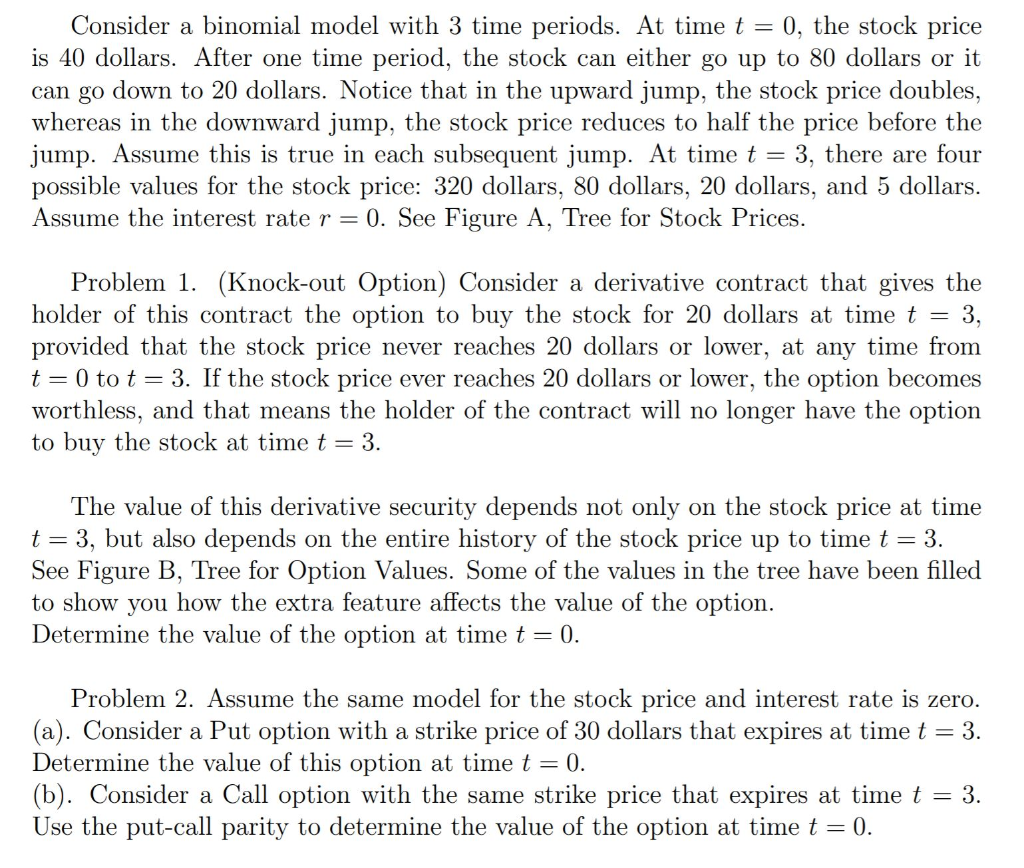 Please answer Problem 2 (a) and (b). Problem 1 is needed as background only to stock prices and interest rate.
Please answer Problem 2 (a) and (b). Problem 1 is needed as background only to stock prices and interest rate.
Consider a binomial model with 3 time periods. At time t = 0, the stock price is 40 dollars. After one time period, the stock can either go up to 80 dollars or it can go down to 20 dollars. Notice that in the upward jump, the stock price doubles, whereas in the downward jump, the stock price reduces to half the price before the jump. Assume this is true in each subsequent jump. At time t = 3, there are four possible values for the stock price: 320 dollars, 80 dollars, 20 dollars, and 5 dollars. Assume the interest rate r = 0. See Figure A, Tree for Stock Prices. Problem 1. (Knock-out Option) Consider a derivative contract that gives the holder of this contract the option to buy the stock for 20 dollars at time t = 3, provided that the stock price never reaches 20 dollars or lower, at any time from t= 0 tot = 3. If the stock price ever reaches 20 dollars or lower, the option becomes worthless, and that means the holder of the contract will no longer have the option to buy the stock at time t = 3. The value of this derivative security depends not only on the stock price at time t = 3, but also depends on the entire history of the stock price up to time t = 3. See Figure B, Tree for Option Values. Some of the values in the tree have been filled to show you how the extra feature affects the value of the option. Determine the value of the option at time t=0. Problem 2. Assume the same model for the stock price and interest rate is zero. (a). Consider a Put option with a strike price of 30 dollars that expires at time t = 3. Determine the value of this option at time t = 0. (b). Consider a Call option with the same strike price that expires at time t = 3. Use the put-call parity to determine the value of the option at time t = 0. Consider a binomial model with 3 time periods. At time t = 0, the stock price is 40 dollars. After one time period, the stock can either go up to 80 dollars or it can go down to 20 dollars. Notice that in the upward jump, the stock price doubles, whereas in the downward jump, the stock price reduces to half the price before the jump. Assume this is true in each subsequent jump. At time t = 3, there are four possible values for the stock price: 320 dollars, 80 dollars, 20 dollars, and 5 dollars. Assume the interest rate r = 0. See Figure A, Tree for Stock Prices. Problem 1. (Knock-out Option) Consider a derivative contract that gives the holder of this contract the option to buy the stock for 20 dollars at time t = 3, provided that the stock price never reaches 20 dollars or lower, at any time from t= 0 tot = 3. If the stock price ever reaches 20 dollars or lower, the option becomes worthless, and that means the holder of the contract will no longer have the option to buy the stock at time t = 3. The value of this derivative security depends not only on the stock price at time t = 3, but also depends on the entire history of the stock price up to time t = 3. See Figure B, Tree for Option Values. Some of the values in the tree have been filled to show you how the extra feature affects the value of the option. Determine the value of the option at time t=0. Problem 2. Assume the same model for the stock price and interest rate is zero. (a). Consider a Put option with a strike price of 30 dollars that expires at time t = 3. Determine the value of this option at time t = 0. (b). Consider a Call option with the same strike price that expires at time t = 3. Use the put-call parity to determine the value of the option at time t = 0
 Please answer Problem 2 (a) and (b). Problem 1 is needed as background only to stock prices and interest rate.
Please answer Problem 2 (a) and (b). Problem 1 is needed as background only to stock prices and interest rate.





